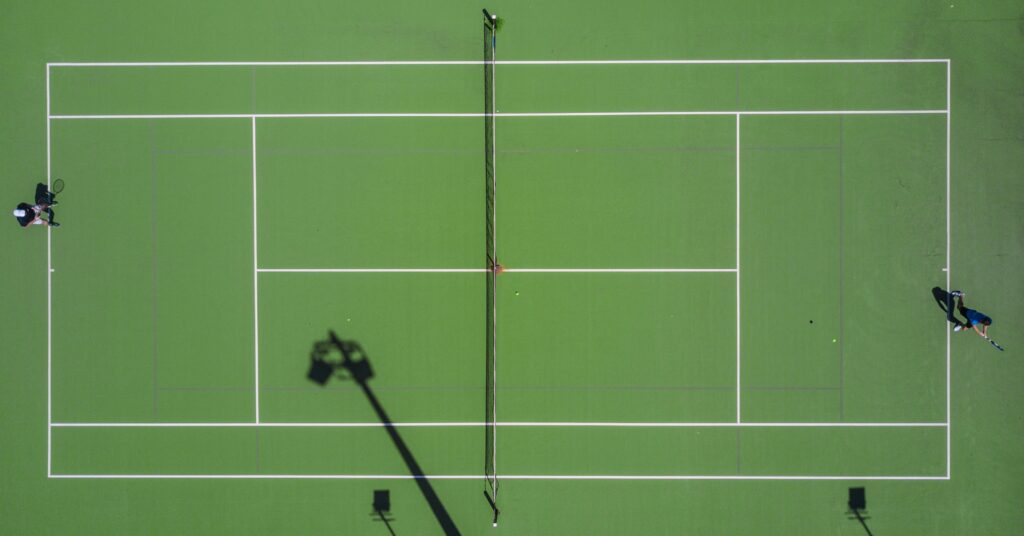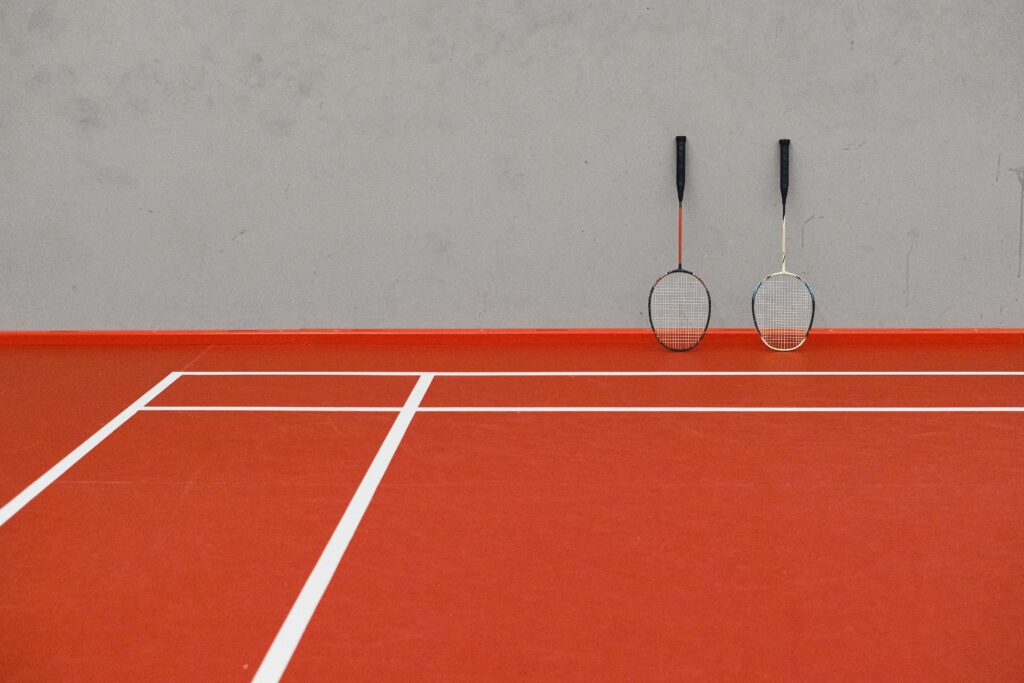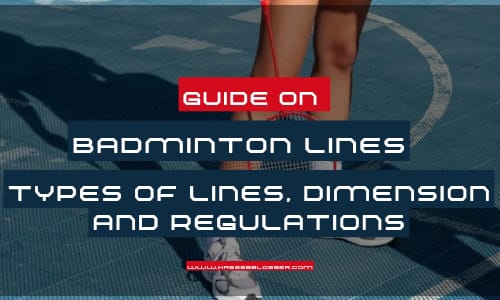Types of Badminton Lines and Their Functions
Badminton lines are the lifeblood of the sport, creating the boundaries for play and dictating the flow of the game. There are several key types of lines, each with its own specific function:
- Boundary Lines: These lines mark the perimeter of the court, indicating the area within which play is permitted. Boundary lines are 6.7 meters long for singles matches and 6.1 meters for doubles matches. For complete information about badminton court simpley click here.
- Centerline: This line divides the court into two equal halves, running parallel to the net and extending from the short service line to the back boundary line.
- Service Lines: These lines are located 1.98 meters from the net on either side of the centerline. Players must serve behind the short service line during underhand service and behind the long service line during overhand service.
- Sidelines: These lines run along the sides of the court, extending from the net to the back boundary line.
- Non-Playing Lines: These lines are located 30 centimeters inside the boundary lines on all sides of the court. Stepping on or outside these lines during play constitutes a fault.
These lines work in concert to define the playing area, dictate service rules, and facilitate fair and organized gameplay.

Marking the Court: A Guide to Badminton Line Positioning
Accurately marking the badminton court is crucial for ensuring fair and consistent gameplay. The Badminton World Federation (BWF) provides strict guidelines for the positioning and dimensions of lines:
- Line Width: All lines must be 40 millimeters wide and clearly visible.
- Line Color: Lines should be white or yellow for optimal visibility against different court surfaces.
- Measuring Tools: Use a calibrated measuring tape and line marker to ensure accurate positioning.
- Verification: Double-check all line measurements for accuracy before playing.
- Maintenance: Regularly check for fading lines and reapply markings as needed.
Following these guidelines ensures a level playing field for all badminton enthusiasts.
Badminton Lines: Dimensions & Regulations
The specific dimensions of badminton lines are precisely defined by the BWF. Here’s a breakdown:
- Court Length: 13.4 meters for singles and 6.7 meters for doubles.
- Court Width: 5.18 meters for singles and 6.1 meters for doubles.
- Net Height: 1.524 meters at the center and 1.555 meters at the sides.
- Short Service Line: 1.98 meters from the net.
- Long Service Line: 3.96 meters from the net.
Understanding these dimensions allows players to confidently navigate the court and execute strategic shots with precision.

Common Badminton Line Violations and Their Consequences
During the heat of competition, unintentional line violations can occur. Here are some common violations and their consequences:
- Foot Fault: Stepping on or outside the non-playing lines during service. This results in a loss of serve.
- Line Fault: Hitting the shuttlecock so it lands outside the boundary lines. This awards a point to the opponent.
- Net Fault: The shuttlecock touches the net during service or play. This results in a loss of serve or point, depending on the situation.
Knowing these violations and their consequences helps players avoid unnecessary penalties and stay focused on the game.
Impact of Badminton Lines on Gameplay and Strategy
The precise layout and dimensions of badminton lines have a significant impact on gameplay and strategy. Different types of lines influence shot selection, footwork, and overall court positioning. For example:
- Short service lines encourage players to engage in net play.
- Deep service lines allow for more powerful overhead smashes.
- Sidelines limit the angles for drop shots.
A thorough understanding of the lines and their functions enables players to develop effective strategies and maximize their performance.
Maintaining Badminton Lines: Tips for Optimal Performance
Maintaining badminton lines in good condition is essential for ensuring fair play and preventing injuries. Here are some tips:
- Use high-quality line marking paint or tape.
- Regularly sweep and clean the court to remove dirt and debris.
- Repaint or replace lines when they become faded or worn.
- Use protective covers for the lines when the court is not in use.
- Store line marking materials in a cool, dry place.
By following these tips, you can extend the lifespan of your badminton lines and ensure a consistently enjoyable playing experience.
The Evolution of Badminton Lines: Historical Perspective
The layout of badminton lines has undergone subtle changes throughout its history. Early versions of the game used lines marked with chalk or string, while modern courts utilize more durable materials like paint or tape. Additionally, the dimensions of the court and service lines have been slightly adjusted over time to refine gameplay and enhance player safety.
Frequently Asked Questions about Badminton Lines:
What are the different types of lines on a badminton court?
There are five main types of lines: boundary lines, the centerline, service lines, sidelines, and non-playing lines. Each type has a specific function and helps define the playing area.
What are the dimensions of a badminton court?
The court length is 13.4 meters for singles and 6.7 meters for doubles. The width is 5.18 meters for singles and 6.1 meters for doubles. The net height is 1.524 meters at the center and 1.555 meters at the sides.
What are the different types of service lines?
There are two types of service lines: the short service line and the long service line. The short service line is located 1.98 meters from the net, and the long service line is located 3.96 meters from the net.
What are the consequences of stepping on the non-playing lines?
Stepping on or outside the non-playing lines during service is a foot fault and results in a loss of serve.
What happens if the shuttlecock hits the line?
If the shuttlecock lands on the line, it is considered in play. However, if the shuttlecock touches the line during service or play, it is a fault and the opponent gains a point.
What is the purpose of the sidelines?
The sidelines mark the edges of the court and help players gauge the direction and angle of their shots. Hitting the shuttlecock so it lands outside the sidelines results in a point for the opponent.
What materials are used to mark badminton lines?
Modern badminton courts typically use high-quality line marking paint or tape for better visibility and durability.
How often should badminton lines be maintained?
Lines should be regularly checked for fading or wear and repainted or replaced as needed. Regular cleaning and sweeping of the court also helps maintain the lines in good condition.
How has the layout of badminton lines changed over time?
Early versions of the game used less durable materials like chalk or string for marking lines. The dimensions of the court and service lines have also been slightly adjusted over time to optimize gameplay and safety.
Why are badminton lines important?
Badminton lines are crucial for defining the playing area, ensuring fair play, and facilitating strategic gameplay. They provide essential visual cues for players, allowing them to execute shots with precision and navigate the court effectively.


1 thought on “Badminton Lines: A Frustrating Labyrinth of Rules and Boundaries 2023”